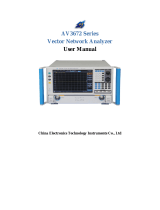
www.salukitec.com
and the frequency conversion scheme is the same as the 5 GHz - 16.5 GHz. The microwave/millimeter-wave
frequency conversion module directly affects the frequency conversion loss, noise factor, image frequency and
off-band signal suppression and gain compression of the main unit, which consists of the broadband
microwave/millimeter-wave switch, low-noise broadband preamplifier, high performance broadband
microwave/millimeter-wave mixer, microwave/ millimeter-wave switch filter module, low power consumption
LO amplifier and multiplying circuit and microwave switch filter module.
2.2 Frequency Synthesis Module
The frequency synthesis module is mainly used to provide the required LO signals to the three mixers in the
microwave/millimeter-wave frequency conversion module and the fourth mixer in the IF signal processing
module. It consists of seven phase-lock loops of 5.3 GHz - 5.55 GHz first LO, 6 GHz - 12 GHz second LO,
3,200 MHz third LO and 109 MHz fourth LO, which will directly determine the phase noise, sweep speed,
sideband stray, etc. of the main unit.
2.3 IF Signal Processing Module
It is mainly used to carry out amplification and IF gain modulation of 140.25 MHz third IF signal output by the
microwave/millimeter-wave frequency conversion module, and then make it enter the acoustic surface wave
filter to suppress the out-of-band frequency, and obtain the fourth IF signal by mixing the third IF signal after
gain adjustment on the third IF channel with the fourth local oscillator and make it as the AD converter input
sampling signal. After AD sampling, it will output the LVDS level to the data processing, display and control
module for IF filtering, video detection, digital down-conversion and video filtering, etc., and finally convert it
to the testing curve and display it on the LCD.
2.4 Data Processing, Display and Control Module
It includes the switch power conversion, digital signal processing, display and touch screen driver, all kinds of
user input and output interfaces required by the main unit and logic control functions of each unit circuit on the
main unit. The data processing, display and control module is mainly used to control the circuit of each module
to complete the measurement of the spectrum analyzer and the processing and display of the measurement data.
It also includes auxiliary functions including the processing of keyboard and touch screen input information,
peripheral control, parameter transformation, data and status storage and recall, measurement result output and
cursor, as well as statistical analysis and functional support of LAN and USB interfaces.
























